I realized in late winter 2019 that I had never walked Canal Street from SoHo all the way east to where it ends at East Broadway, despite there being some interesting and historic items to be found along the way. The reason for it is simple. I avoid noise and crowds, and Canal is among the noisiest streets in New York City because it’s a major truck route. In the 1960s, NYC traffic czar Robert Moses was thwarted in his attempt to build a Lower Manhattan Expressway connecting the Manhattan and Williamsburg Bridges to the Holland Tunnel. It would have involved an elevated highway running down Broome Street, not that I would have favored such a thing. (I would have favored a vehicular tunnel under Manhattan connecting the bridges and tunnel.)
With no express roadway, truck traffic employs Canal Street to get from, say, Brooklyn to New Jersey, and NYC drivers, especially truck drivers, are horn happy when they are feeling thwarted or delayed and the sharp, sudden horn noise can be maddening. Canal Street’s small retail businesses, which often involved sidewalk displays, have always attracted large crowds. Unfortunately in recent years, such small businesses have been priced out by rising rents, as Nathan Kensinger relates in a 2018 Canal Street feature in Curbed.
Nevertheless I girded my loins and sallied forth on a relative early Saturday morning around 10 and found things relatively bearable along Canal, and I also got in some scenes in SoHo and the Lower East Side I will jot down in future FNY pages — but this particular feature will deal with Canal exclusively.
While the storefronts on western Canal Street in the old art supplies and hardware districts have largely shuttered, awaiting what is likely a luxury co-op building fate, Canal Street’s Chinatown sector between Centre Street and the Manhattan Bridge entry at the Bowery remains bustling and chockablock with street life, including grocery stalls set up on the curblines.
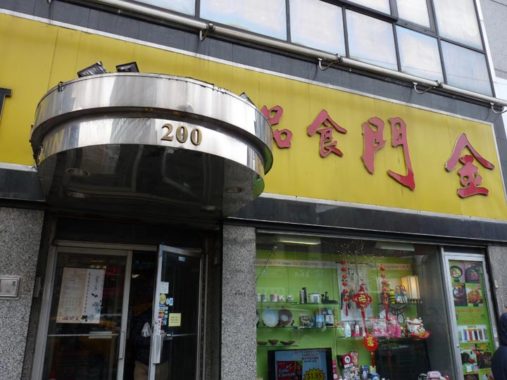
Many of the storefront signs are entirely in Chinese characters and impenetrable to those who do not read the language. Historically, Cantonese has been spoken in Manhattan’s Chinatown, as most of its immigrants came from Guangdong (Canton), Hong Kong or Macau; many Chinese here nonetheless have some knowledge of Mandarin, which has rapidly made inroads in Chinatown. Meanwhile, Chinese in the Two Bridges area between the Manhattan and Brooklyn Bridges are from Fijian and speak Mindong.

This section of Canal Street, and adjoining blocks north of Canal Street on the Bowery, are known for wholesale and retail jewelry stores.
American Legion Post 1291, 193 Canal Street, is known as the Lt. B.R. Kimlau Post, so named for a Chinese-American bomber pilot killed during World War II in New Guinea.
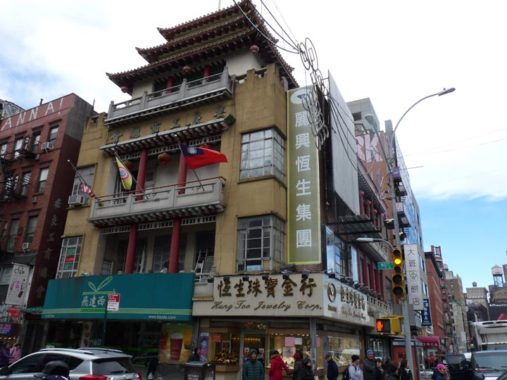
The second of Canal Street’s major pagoda-like buildings can be found at $83 Mott Street on the southwest corner of Canal. Known as the On Leong Tong Building, it was built in 1950 and is the work of architect Poy Gum Lee, who worked mainly in Shanghai; this is his only major NYC building, though he also designed the WWII monument in Chatham Square, Bowery at East Broadway, which is also known as Kimlau Square (see above).
In 1964, the Department of Traffic (now Transportation) installed pagoda-like coverings on pandant light fixtures, mostly on the new Donald Deskey poles that were installed during that time. After several years when they were replaced with conventional lamps when the fixtures gave out, they reappeared in the 1980s and now, many Chinatown streets boast them, as here on Mott Street.
The domed HSBC Bank building on the southeast corner of Bowery and Canal Street was built in 1924 [Clarence Brazer, arch.] as Citizen’s Savings Bank. A pair of bronze lions guard the exterior.
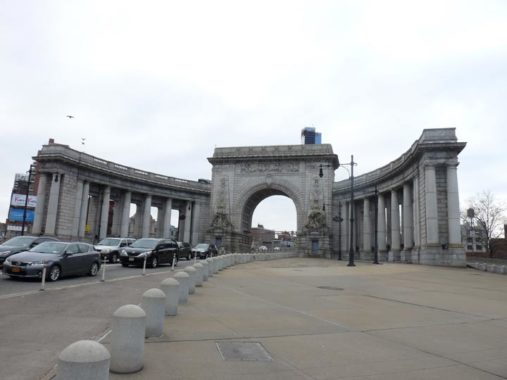
Above we see the Manhattan Bridge’s triumphal arch and colonnade… an attraction the Brooklyn, Williamsburg, Queensboro, and Triboro (soon to be RFK) Bridges lack. The Manhattan Bridge was constructed between 1901 and 1912 (it was proposed as far back as 1892) with Rudolph Modjeski and Othniel Foster Nichols as chief engineers and Leon Moiseiff as design engineer. [Steve Anderson recounts the details behind the bridge’s construction at nycroads.com.]
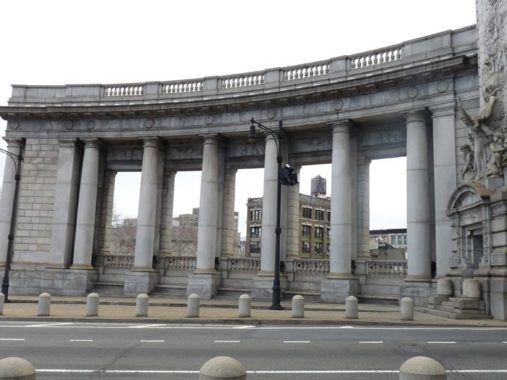
The grand Manhattan Bridge plaza, which fronts the Bowery at Canal Street, was completed in 1916 and is the design of John M. Carrere and Thomas Hastings, who also built the New York Public Library at 5th Avenue and 42nd Street. They looked to two classic European monuments for inspiration: The Porte St-Denis in Paris (the arch) and the Giovanni Bernini Colonnade at St. Peter’s Church in Vatican City.
The Porte St-Denis and Porte St-Martin in Paris are triumphal arches that celebrate military victories by “the Sun King”, Louis XIV. The St-Denis arch was completed in 1674 by sculptor Nicolas François Blondel. Bas-reliefs on the top and sides commemorate war campaigns and victories. Both arches greatly influenced the later Arc de Triomphe in Paris and the Manhattan Bridge arch, which as you can see is a close homage.
The arch differs from the St-Denis arch in that it depicts two allegorical characters on either side of the roadway: the Spirit of Commerce on the north side, and the Spirit of Industry on the south side. Both are the work of sculptor Carl Augustus Heber.
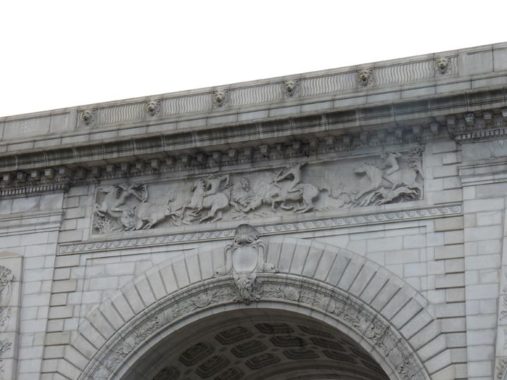
At the top of the arch is a frieze depicting Indians hunting buffalo by sculptor Charles Cary Rumsey, with a buffalo head at the keystone of the arch.
In some ways, the bridge’s sculptors present mixed metaphors. While Rumsey celebrated the Old West (odd, since the bridge points east), the Carrere and Hastings design does not allow us to forget the river the bridge crosses: on the arch’s interior, what looks like the Creature of the Black Lagoon presides over a mix of seashells and conches. Other sea-themed sculptures can be seen on the arch. The soffit, or underside, of the arch is inlaid with 3 rows of carved rosettes.
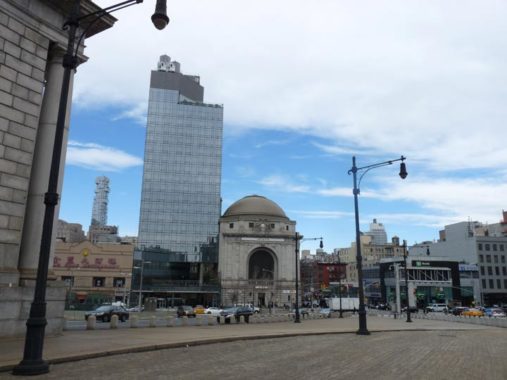
For many years the Manhattan Bridge arch was poorly cared for and accumulated a patina of exhaust fumes and general soot. When it was finished in 1916 the auto was still in its infancy as far as a mass means of transportation and trolleys and horsecarts still traversed it; modern-day pedal-to-the-metal motorists cannot safely admire its plaza details, and it’s admittedly difficult for pedestrians to get at it. Thankfully the city power-washed the arch and colonnade a few years ago, and rebuilt the plaza.
The improvements also marked the DOT’s removal of some very old lampposts that had been allowed to survive at the plaza, and installed new ones with thick Type G-type bases and shafts. This species of post was also installed on Eastern Parkway between Washington and Utica Avenues in Brooklyn around the same time.
Sara D. Roosevelt Park is a lengthy corridor running between Chrystie, Forsyth, Canal and Houston Streets. The park is named for the mother of President Franklin Delano Roosevelt. Land between Chrystie and Forsyth Streets was acquired by the city, which planned to build low-cost housing, but built a corridor park instead and named it for Mrs. Roosevelt in 1934, two years after the ascension of her son to the White House.
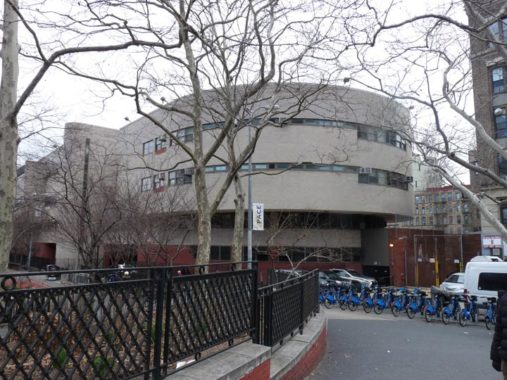
It looks like a parking garage but it’s actually Intermediate School #131, or the Dr. Sun Yat-Sen School at Hester and Forsyth, built in 1983. Described in the AIA Guide to NYC: “Curvilinear, extroverted, expansive.”
Who is that guy? Dr. Sun Yat-Sen (Sun Yixian) (1866-1925), was the first president of the short-lived Republic of China, which ruled China after the Qing dynasty was overthrown in 1911 and Japanese occupation during WWII and later, the Communist revolution of 1949.
Some homemade sidewalk signage along Canal Street on the two blocks between Forsyth and Allen Streets.
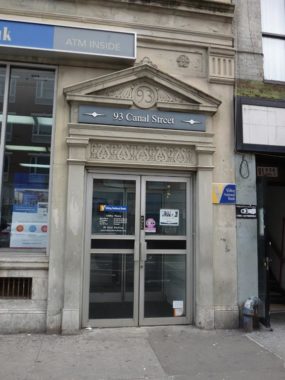
I don’t know the story behind 93 Canal Street but there is some interesting stone work on the pediment and above the door.
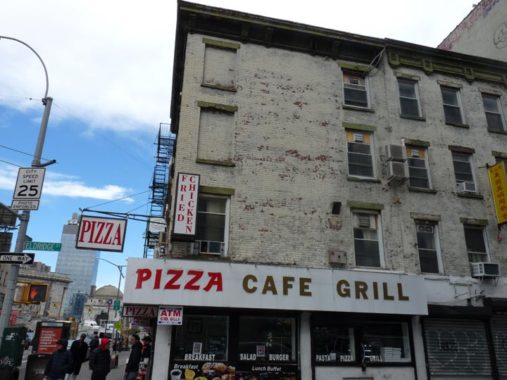
The “pizza cafe” on the northwest corner of Canal and Eldridge was once a longtime hole-in-the-wall diner Cup & Saucer, which had existed for 3/4 century and had been under the same management for 25 years. The New York Times reported that the landlord had authorized a 93% rent increase, and thus, the diner was forced out in 2017.
At that price, you would think a bank or a Starbucks would have moved in, but the pizzeria is there now.
Allen Street runs from Division and Pike Streets north to East Houston Street and 1st Avenue. Until 1940 the tracks of the 2nd Avenue El rumbled above it and in 1931, the city’s Department of Traffic decided to give it some extra lanes, demolishing a number of tenement buildings, and creating a center mall, to facilitate traffic movement between South and Houston Streets. Beginning in 2004 the city went a step further, adding bike lanes and tables and seats to the mall.
Some longstanding importing and wholesaling businesses can still be found along Allen Street. Stephen Allen (1767-1852), was the 55th NYC mayor from 1821 to 1824 and a sailmaking entrepreneur before entering politics; his vault in the New York City Marble Cemetery on East 2nd Street is marked by a large tapering shaft topped by a globe just to the left of the cemetery entrance. In 2010, Viennese immigrant Eddie Feibusch was still distributing zippers from his speciality store on Allen Street.
Scenes from Allen Street’s elevated railroad days can be seen in the NYC Municipal Archives.

Jarmulovsky’s Bank, on the southwest corner of Canal and Orchard Streets, was built as a privately-owned bank in 1912 by former street merchant Sender Jarmulovsky, who started a bank with his savings in 1873, catering to his fellow Lower East Siders of modest means. For its first few years, Jarmulovsky’s bank was a genuine success in a neighborhood of savers, and he hired the architectural firm of Rouse and Goldstone to build a magnificent bank building. Sender Jarmulovsky passed away shortly after the building opened, believing he had started an institution that would pass the test of time; but the bank did not survive World War I.
The building itself has been covered in construction netting since 2014 as it undergoes renovations converting it to a hotel, with no end in sight by mid-2019.
#5 Ludlow, just north of Canal, is the former home of the Kletzker Brotherly Aid Society, formed by immigrants from Kletz, Poland, in 1892. The organization provided funds for funerals, children’s aid and medical care for members. It has long been occupied by funeral homes, Jewish, Italian and Chinese, but its original purpose is still rendered on the roofline.

Tung Goon Association (a benevolent association) HQ at 3 Ludlow, off Canal. The present doorway is much narrower than the pediment, evidence of a remodeling at some time in the past.
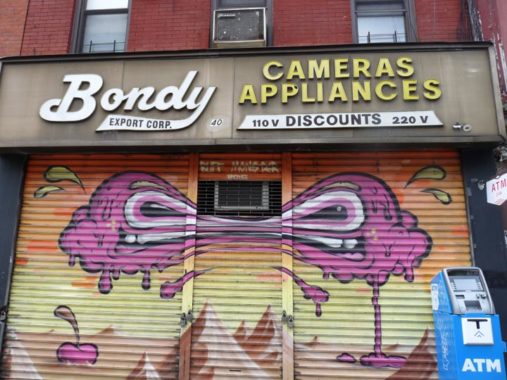
Despite passing often, I have never seen Bondy Cameras & Appliances at 40 Canal Street actually open, but it is indeed and has been in this location since 1953.
143 Division Street at Canal is presently the easternmost address on Division Street. I say “presently” because Division Street formerly extended northeast to Grand and Gouverneur Streets; but northeast of here, that section is now occupied by the Seward Park Cooperative, opened in 1960.
Despite its narrowness, the 2nd Avenue El once rumbled above Division Street between the Bowery and Allen Street.
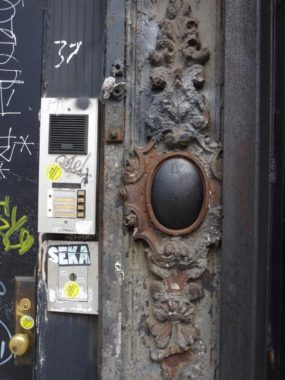
Some pretty substantial detail at the buzzer of the doorway of 37 Canal Street at Ludlow.
The Canal Street Loew’s Theater, built by prolific theater designer Thomas Lamb and completed in 1927, had a seating capacity of 2,270. The façade is faced in glazed white terra cotta, richly decorated with masks, wreaths, griffins and other classical ornamentation. Triple-arched faux windows, glazed in black and framed with urns and foliage, are surmounted by an elaborate cornice. —(Lower East Side Remembered & Revisited)
On April 17, 1940 large crowds turned up for the opening of “Forty Little Mothers” starring Eddie Cantor, who was born a few blocks away on Eldridge Street. The theater closed in the 1960s and the interior was gutted. For several years an electronics store occupied the space and the old sign is still on the exterior, so there’s two relics in one here.
Canal Street ends its eastern run at Straus Square, East Broadway at Rutgers. It was named for Jewish philanthopist Nathan Straus (1848-1931), a partner with his brother Isidor in the giant Macy’s department store early in the 20th Century, assisted and funded a program distributing pasteurized and sterilized milk to children countrywide. He also championed a Jewish state in Palestine, a cause he did not live to see.
Straus Square was originally named for patriot Henry Rutgers, whose hundred-acre farm was nearby. Both Henry and Rutgers Streets and Rutgers University are also named for him. The square was a political epicenter, regularly hosting rallies and demonstrations. It was renamed for Straus in 1931, the year of Nathan Straus’ death.
Though Canal Street ends its eastern run here. its house numbering starts here, running east to west (as does Broome Street’s). This seems counterintuitive, but there’s no hard and fast rule about what direction house numbers ascend in Manhattan, with the exception of East and West numbered streets that are divided by Broadway and then 5th Avenue north of Washington Square.
Facing Straus Square is the recently renovated (for expensive living spaces) Jewish Daily Forward Building. The word Forverts, or Forward, in Hebrew characters is spelled below the clock at the roofline. The building was designed in 1911 by architect George Boehn to house the offices of the influential then-daily founded by Abraham Cahan in 1897. It quickly became the most influential newspaper in the Jewish community and was an early example of advocacy journalism, fighting to eliminate sweatshops, supporting the labor movement and battling corrupt politicians. The Forward moved uptown years ago and the building then housed the Chinese Center and then became upscale living space.
Likenesses of four prominent European socialists appear above the front entrance: Karl Marx, Friedrich Adler, Ferdinand Lassalle and Friedrich Engels.
That’s all I have on Canal Street, but for many more photos and more information, consult Nathan Kensinger’s Curbed piece on Canal.
Check out the ForgottenBook, take a look at the gift shop, and as always, “comment…as you see fit.”
4/21/19


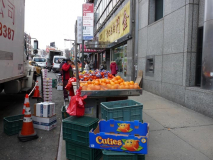
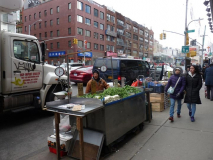
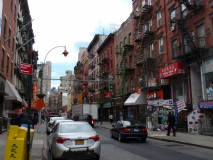
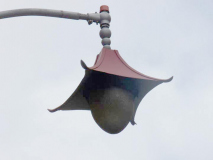
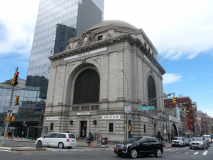
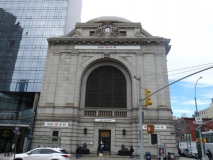

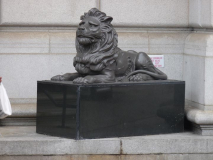

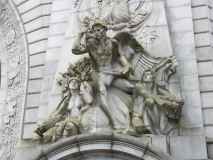
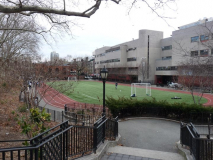
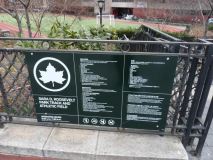


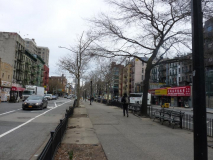
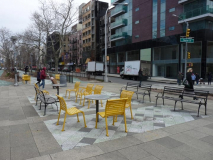
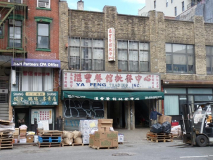

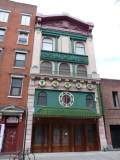

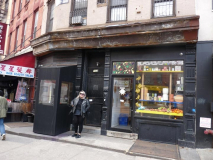
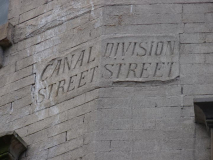
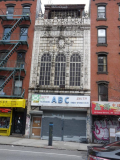
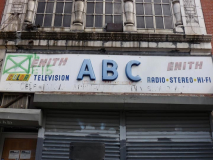
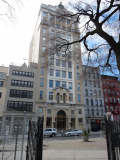
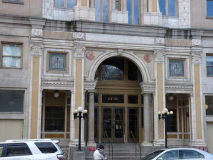
6 comments
First of all, there may not have been much opposition to the LOMEX if it had been built on Canal Street only. I really don’t see why Robert Moses didn’t do it that way especially when it wouldn’t have resulted in any lost property. Meanwhile, the area shown after the Manhattan Bridge is the route I take whenever I come back from Brooklyn via the Manhattan Bridge for the Montgomery Street entrance to the FDR Drive like I did yesterday after the Nets game. The rest of the route involves turning left onto East Broadway and following it to Montgomery Street where you need to turn right and then left when getting to the FDR Drive for the northbound side. However, to get that route, you have to be on the upper roadway of the bridge by being on the right hand side after Tillary Street or you can’t get to that and you will have to enter the FDR Drive at Houston Street instead.
About the Canal Street Loew’s Theater that was converted into the ABC Television/Radio/Stereo store…
I’ve mentioned elsewhere on your excellent website that I was inside ABC a few times when I was a kid in the 1960s. My dad would shlep us all the way form Brooklyn to ABC to buy TVs and –one time— a small reel-to-reel tape recorder for me. When you’d enter the shop, there was a counter where the clerks would greet you. There was no hint as to how big the shop was or what the building’s original purpose was. You could not go beyond the counter to see the shop’s wares. You’d place your order and it would be brought out to you. Apparently, the front counter must’ve been in what was the theater’s front foyer and the theater itself served as a warehouse.
93 Canal Street was The Merchant’s Bank in 1934.
Engels wasn’t Jewish.
All right, changed the adjective
The then longtime business at 97 Canal
(Belenky Brothers)
convened at the Cup n’Saucer every
morning: good-natured ribbing and back-and-forth.
The coffee shop added pizza in its later days;
ultimately did not matter.